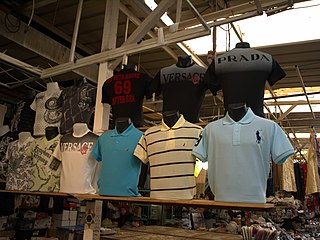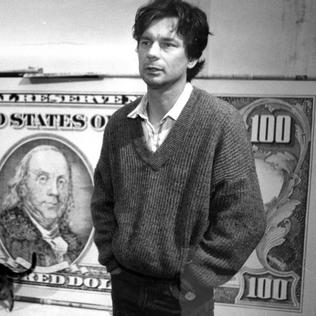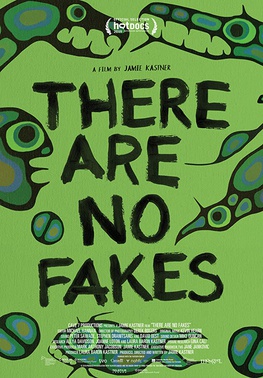
Henricus Antonius "Han" van Meegeren was a Dutch painter and portraitist, considered one of the most ingenious art forgers of the 20th century. Van Meegeren became a national hero after World War II when it was revealed that he had sold a forged painting to Reichsmarschall Hermann Göring during the Nazi occupation of the Netherlands.

Forgery is a white-collar crime that generally refers to the false making or material alteration of a legal instrument with the specific intent to defraud. Tampering with a certain legal instrument may be forbidden by law in some jurisdictions but such an offense is not related to forgery unless the tampered legal instrument was actually used in the course of the crime to defraud another person or entity. Copies, studio replicas, and reproductions are not considered forgeries, though they may later become forgeries through knowing and willful misrepresentations.

To counterfeit means to imitate something authentic, with the intent to steal, destroy, or replace the original, for use in illegal transactions, or otherwise to deceive individuals into believing that the fake is of equal or greater value than the real thing. Counterfeit products are fakes or unauthorized replicas of the real product. Counterfeit products are often produced with the intent to take advantage of the superior value of the imitated product. The word counterfeit frequently describes both the forgeries of currency and documents as well as the imitations of items such as clothing, handbags, shoes, pharmaceuticals, automobile parts, unapproved aircraft parts, watches, electronics and electronic parts, software, works of art, toys, and movies.

James Stephen George Boggs was an American artist, best known for his hand-drawn depictions of banknotes. Due to his pre-Bitcoin philosophical questions about the value of fiat currency, his early interest in creating his own currency, and his contributions to an "encrypted online currency" as early as 2000, Boggs was described by Artnet as the Patron Saint of Cryptocurrency.

Art forgery is the creation and sale of works of art which are falsely credited to other, usually more famous artists. Art forgery can be extremely lucrative, but modern dating and analysis techniques have made the identification of forged artwork much simpler.
John Drewe is a British purveyor of art forgeries who commissioned artist John Myatt to paint them. Drewe earned about £1.8 million executing these art crimes.

Elmyr de Hory was a Hungarian-born painter and art forger, who is said to have sold over a thousand art forgeries to reputable art galleries all over the world. His forgeries garnered celebrity from a Clifford Irving book, Fake (1969), and a documentary essay film by Orson Welles, F for Fake (1974).
Brígido Lara is a Mexican artist and ex-forger of pre-Columbian antiques. Lara claims to have created perhaps as many as 40,000 pieces of forged pre-Columbian pottery.

F for Fake is a 1973 docudrama film co-written, directed by, and starring Orson Welles who worked on the film alongside François Reichenbach, Oja Kodar, and Gary Graver. Initially released in 1974, it focuses on Elmyr de Hory's recounting of his career as a professional art forger; de Hory's story serves as the backdrop for a meandering investigation of the natures of authorship and authenticity, as well as the basis of the value of art. Far from serving as a traditional documentary on de Hory, the film also incorporates Welles's companion Oja Kodar, hoax biographer Clifford Irving, and Orson Welles as himself. F for Fake is sometimes considered an example of a film essay.

Counterfeit money is currency produced without the legal sanction of a state or government, usually in a deliberate attempt to imitate that currency and so as to deceive its recipient. Producing or using counterfeit money is a form of fraud or forgery, and is illegal. The business of counterfeiting money is nearly as old as money itself: plated copies have been found of Lydian coins, which are thought to be among the first Western coins. Before the introduction of paper money, the most prevalent method of counterfeiting involved mixing base metals with pure gold or silver. Another form of counterfeiting is the production of documents by legitimate printers in response to fraudulent instructions. During World War II, the Nazis forged British pounds and American dollars. Today some of the finest counterfeit banknotes are called Superdollars because of their high quality and imitation of the real US dollar. There has been significant counterfeiting of Euro banknotes and coins since the launch of the currency in 2002, but considerably less than that of the US dollar.

Identity document forgery is the process by which identity documents issued by governing bodies are copied and/or modified by persons not authorized to create such documents or engage in such modifications, for the purpose of deceiving those who would view the documents about the identity or status of the bearer. The term also encompasses the activity of acquiring identity documents from legitimate bodies by falsifying the required supporting documentation in order to create the desired identity.

In general, philatelic fakes and forgeries are labels that look like postage stamps but have been produced to deceive or defraud. Learning to identify these can be a challenging branch of philately.

Literary forgery is writing, such as a manuscript or a literary work, which is either deliberately misattributed to a historical or invented author, or is a purported memoir or other presumably nonfictional writing deceptively presented as true when, in fact, it presents untrue or imaginary information or content.
Shaun Greenhalgh is a British artist and former art forger. Over a seventeen-year period, between 1989 and 2006, he produced a large number of forgeries. With the assistance of his brother and elderly parents, who fronted the sales side of the operation, he successfully sold his fakes internationally to museums, auction houses, and private buyers, accruing nearly £1 million.
Fake memoirs form a category of literary forgery in which a wholly or partially fabricated autobiography, memoir or journal of an individual is presented as fact. In some cases, the purported author of the work is also a fabrication.

Authenticity in art is manifest in the different ways that a work of art, or an artistic performance, can be considered authentic. The initial distinction is between nominal authenticity and expressive authenticity. In the first sense, nominal authenticity is the correct identification of the author of a work of art; of how closely an actor or an actress interprets a role in a stageplay as written by the playwright; of how well a musician's performance of an artistic composition corresponds to the composer's intention; and how closely an objet d’art conforms to the artistic traditions of its genre. In the second sense, expressive authenticity is how much the work of art possesses inherent authority of and about its subject, and how much of the artist's intent is in the work of art.
The following outline is provided as an overview of and topical guide to forgery:
Forgery is used by some governments and non-state actors as a tool of covert operation, disinformation and black propaganda. Letters, currency, speeches, documents, and literature are all falsified as a means to subvert a government's political, military or economic assets. Forgeries are designed to attribute a false intention and aspirations on the intended target. They force the targeted government to spend a large amount of resources to refute the forgery. Forgeries are an effective tool because of their ability to hold influence even after being proven false.

There Are No Fakes is a Canadian documentary film, directed by Jamie Kastner and released in 2019. Starting with musician Kevin Hearn's lawsuit against the Maslak McLeod Gallery after being informed that a Norval Morrisseau painting he had purchased appeared to be a forgery, the film expands into an exposé of a significant art fraud ring that has produced many fake Morrisseau paintings through the use of forced child labour in sweatshops, in which some of Morrisseau's own surviving family members are complicit; by some estimates, there may be up to 10 times as much fake Morrisseau art on the market as real work.












